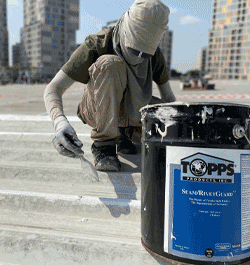UP TO THE MINUTE
Signs to Look for That Indicate if it is Time for a New Roof

By Metal Roofing Alliance.
Do you know the key signs of a roof’s expiration? This guide has the answers for you!
Editor’s note: The Metal Roofing Alliance (MRA) has organized the Residential Metal Roofing Buyer’s Guide to help homeowners learn about the basics of roofing. This article discusses the question of “is it time for a new roof?” using a passage from the guide.
Making the decision to re-roof your home is a big deal, and it can be a big investment both time and finance wise. The Metal Roofing Alliance (MRA) is dedicated to educating homeowners on the basic signs of roof aging, damage and decay so that they are aware of when it is time to make the big leap and start the re-roofing process. This article, a passage in the informative Residential Metal Roofing Buyer’s Guide, will walk you through the steps of identifying the key signs of a roof’s expiration.
So how do you know when it’s time to put on a new roof? Here are a few signs that it may be time to consider re-roofing your home:
- Missing or loose roofing material: this includes either a large quantity of missing material or a re-occurring issue that must be addressed frequently.
- Damaged roofing material which may include curling, cracking, blistering, staining or breakage: anything that visually indicates the material is reaching the end of its life.
- A sagging roof: could indicate your roof is weak and deteriorating, it was improperly installed or that it might be supporting too much weight.
- With asphalt roofing, when there are large amounts of granules in your gutters, downspouts or anywhere there is water run-off from the roof. Shingles typically lose more and more granules as they age, leaving the shingle unprotected. Over time the shingles become brittle and fail, allowing water to enter your home.
- Exposed or loose nail heads which could mean increased susceptibility to water penetration and potential leaks in the roof.
- Any water damage inside your home or attic may indicate that your roof has deteriorated. This increases the chance of mold and mildew growth which can result from inadequate roof ventilation.
- Missing or damaged flashings, curbs or roof jacks increase the opportunity for water to leak into your home.
- If your heating or cooling bills have gotten noticeably higher. This may be a result of insufficient attic ventilation which may impact airflow and prevent moisture from leaving your attic. A damaged or leaking roof will also allow water into an attic. The Department of Energy states every 10% increase in moisture content within the insulation equals a 25% loss in the R-value, the ability to insulate the home.
- Depending on your roof composition, the age of your roof alone may be a good indicator that it’s time to be replaced. Further, if the roof was installed over the top of the previous roof (example: shingles on top of shingles), then you may need to replace your roof even sooner.
If your roof is showing any of these signs, it may be time to start planning for a new roof. This Buyer’s Guide will walk you through various aspects of the re-roofing process… from things to consider when selecting a new roof to material comparisons and options to questions you should ask your roofing professional. It is our goal to assist you in your re-roofing journey and to help make your experience as seamless as possible.
Is it time for a new roof? Use this checklist to find out:
Roof:
- Inspect the ground, use binoculars if necessary. Walking on an aged asphalt shingle roof can be dangerous and can also further damage the roof.
- Look for cracked, curled, and missing shingles or ridge and hip caps.
- Watch for areas of missing granules including “bald” shingles.
- Look at flashings (including pipe flashings) for cracked or missing rubber or sealants as well as for rust and other deterioration.
- Look at roof protrusions and sidewall intersections for signs of water intrusion, rot, etc.
- Inspect skylights for signs of deterioration. Generally speaking, skylights over 10 years old should probably be replaced.
- Inspect eaves for signs of water backing up or rot
Attic:
- A great deal can be learned about your roof from an attic inspection.
- Professional roofing contractors should inspect your attic. Doing your own inspection is also wise.
- Inspect the underside of the roof deck for staining which indicates signs of water infiltration or rot. Also look for cracked decking and structural lumber or missing decking pieces.
- Look for mold, mildew, or other results of condensation and excessive moisture.
- Using a protimeter, check moisture levels in your attic’s insulation, structural lumber and roof decking. Moisture levels over 10% are usually a concern.
- Observe and understand the ventilation in your attic. Most homes are constructed to require both intake vents, usually in the overhangs, and exhaust vents at or near the ridge of the roof. Make sure that the intake vents are not blocked by insulation or other things. Using a smoke pen or light piece of tissue paper, you should be able to detect air movement from the bottom of the attic to the peak. There are code requirements for ventilation and your contractor should be able to help determine if your home meets those.
Original article source: MRA
Learn more about Metal Roofing Alliance (MRA) in their Coffee Shop Directory or visit www.metalroofing.com.
About The Metal Roofing Alliance (MRA)
Representing the residential metal roofing industry in the United States and Canada, the Metal Roofing Alliance (MRA) was formed to help educate consumers about the many benefits of metal roofing. For more information about MRA membership, residential metal roofing resources and tools, visit MRA at www.metalroofing.com.
Recommended For You

Introducing a New Podcast for Roofers
Read More ...
The Ultimate Guide for Spray Roof Coating Systems
Read More ...
Go for gold with these cleaning practices
Read More ...













Comments
Leave a Reply
Have an account? Login to leave a comment!
Sign In